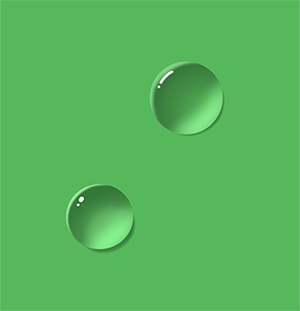How to draw water
How to draw water
Learn How to Draw Water in 6 Different Ways
Water is an essential part of our lives; but in art, it can be a rather challenging subject to draw. Unlike flowers or animals, water is transparent and has no color. In fact, we usually see water due to its relationship to other objects, such as a clear drinking glass. So, how do you sketch this ambiguous compound?
Here we will learn how to draw water in six different ways: a water drop, water in a glass, human tears, running water, an ocean, and a puddle. All you’ll need is a pencil, eraser, pen, and some paper. Ready to get started? Then, let’s draw water!
How to Draw a Water Drop
Step 1: Draw a soft wave
Photo & Art: Margherita Cole | My Modern Met
First, draw a soft wave to create half of the water drop.
Step 2:
Photo & Art: Margherita Cole | My Modern Met
Complete the water drop by drawing the other half.
Step 3: Add some shading
Photo & Art: Margherita Cole | My Modern Met
Fill in the water drop with a mix of hatch marks and crosshatching, focusing mostly on the bottom of the drop.
Step 4: Go over the drawing in ink
Photo & Art: Margherita Cole | My Modern Met
Lastly, go over the drawing in ink. After the ink is dry, erase any remaining pencil marks, and voila! You’ve drawn a drop of water.
How to Draw Water in a Glass
Step 1: Draw a glass
Photo & Art: Margherita Cole | My Modern Met
Begin by sketching a simple drinking glass. Consider using a reference photo to help you out.
Step 2: Add an oval
Photo & Art: Margherita Cole | My Modern Met
Add a narrow oval within the glass. Its location will depend on how full you want the glass to be. It is about halfway full in the drawing above.
Step 3: Add some texture
Photo & Art: Margherita Cole | My Modern Met
Next, we’re going to give our drawing depth by adding texture to the glass and water. Use a combination of hatch marks and crosshatching to achieve this, and make sure to follow the curve of the glass.
Step 4: Go over the drawing in ink
Photo & Art: Margherita Cole | My Modern Met
Lastly, it is time to finish the drawing by going over it in ink. Using the pen of your choice, carefully trace over the pencil lines. Congrats! You’ve drawn a glass of water.
How to Draw Tears
Step 1: Draw an eye
Photo & Art: Margherita Cole | My Modern Met
First, you must draw a human eye. This can be as realistic or stylized as you want.
Step 2: Sketch a small oval
Photo & Art: Margherita Cole | My Modern Met
Next add a small oval within the eye, close to the water line (the bottom of the eye).
Step 3: Add a small drop of water
Photo & Art: Margherita Cole | My Modern Met
Next, draw a water drop a little below the eye to create the tear. You can use the instructions from the first tutorial to complete this step.
Step 4: Go over the drawing in ink
Photo & Art: Margherita Cole | My Modern Met
Lastly, go over the drawing in ink and add any necessary texture. All done!
How to Draw Running Water
Step 1: Draw a faucet
Photo & Art: Margherita Cole | My Modern Met
In this example, the running water will be coming out of a sink faucet. So, draw a curved tube shape and cap it off with a square head.
Step 2: Add two lines
Photo & Art: Margherita Cole | My Modern Met
Next, we’re going to create the stream of water by adding two straight lines to the cap of the faucet.
Step 3: Add texture
Photo & Art: Margherita Cole | My Modern Met
Fill in the faucet and water with texture. You can use a mix of hatch marks and crosshatching to do this. The lines in the water will help create the illusion that the water is moving
Step 4: Go over the drawing in ink
Photo & Art: Margherita Cole | My Modern Met
Finally, it is time to go over the drawing in ink. Use the pen of your choice to carefully trace over the pencil lines. Then, when you’re sure the ink has had enough time to dry, erase any remaining pencil marks. Good job!
How to Draw an Ocean
Step 1: Draw a wavy line
Photo & Art: Margherita Cole | My Modern Met
Start your illustration by drawing a wavy, horizontal line.
Step 2: Add more wavy lines
Photo & Art: Margherita Cole | My Modern Met
Then, starting just below the horizontal line, create texture by adding some wavy and loopy lines.
Step 3: Finish adding texture
Photo & Art: Margherita Cole | My Modern Met
Keep adding texture until you’ve filled the body of water.
Step 4: Go over the drawing in ink
Photo & Art: Margherita Cole | My Modern Met
Lastly, it is time to go over the drawing in ink. Then, when the ink is dry, erase any remaining pencil marks. You’ve completed an illustration of the ocean!
How to Draw a Puddle
Step 1: Draw a narrow oval
Photo & Art: Margherita Cole | My Modern Met
First, sketch a long, narrow oval.
Step 2: Draw another narrow oval
Photo & Art: Margherita Cole | My Modern Met
Next, draw another oval that intersects with the first one.
Step 3: Merge the ovals
Photo & Art: Margherita Cole | My Modern Met
Merge the two ovals by erasing the pencil marks inside of the combined shape.
Step 4: Add some texture
Photo & Art: Margherita Cole | My Modern Met
Afterward, add some texture within the puddle to give it depth. You can use wavy lines that follow the curvature of the puddle. Feel free to add texture to the surrounding environment as well. Stippling is great for rendering dirt, for example.
Step 5: Go over the drawing in ink
Photo & Art: Margherita Cole | My Modern Met
Finally, using the pen of your choice, go over the drawing in ink. Congratulations! You’ve drawn a puddle.
How to Draw Water in Nature
Water is very tricky to draw, because we can see it through its interaction with objects nearby, and it doesn’t look like an object itself. But «tricky» doesn’t mean «impossible»—with a proper method you can create believable water using pencils only!
In this tutorial I will show you how to draw waves under an object, a reflection on a big body of water (like a lake or sea), and a waterfall.
What You Will Need
1. Draw Water in Close-Up
Step 1
First, prepare some kind of object—water will reveal itself by what’s reflected in it.


Step 2
Use a hard brush to sketch the outline of the reflection.

Step 3
Draw a wavy pattern under the object. The farther the waves are, the tighter they should be.

Step 4
The waves intersect with each other, creating outlined areas. Fill some of them:


Step 5
Cross the white areas between the shapes with thick lines.

Step 6
Take the softest pencil and press strongly to darken parts of the shapes. Which parts?
Step 7
Take a soft pencil and fill in the areas between the dark shapes.

Step 8
Use the same pencil to sharpen some of the shadows within the reflection. I also added a shadow under the tail.

Step 9
Take the softest pencil and use it to accentuate some parts.

2. Draw a Lake/Sea
Step 1
Technically, we could use the same method as before to draw a reflection on a lake or sea, but because they’re so big, it wouldn’t be very effective. Instead, we can use a shortcut.
Of course, first you need something that will be reflected in the water. You can use my tutorials to create it:
Step 2
It’s very important to use a proper perspective for the reflection. You can’t simply mirror the shore!

Step 3
Use a hard pencil to sketch the reflection. It doesn’t need to be a very faithful copy of the shore.

Step 4
Take the softest pencil and draw the waves under the dark objects. The sky is very bright, so it doesn’t need to be reflected. That’s how we’ll save some time!


Step 6
Press even harder when close to the shore to make the border between water and land more visible.

3. Draw a Waterfall
Step 1
The waterfall is basically water flowing down over something, so we need to create some kind of base for it first. A pile of rock will be perfect for this purpose. You can learn how to draw it from my tutorial How to Draw Grass, Ground, and Rocks.

Step 2
Use a hard pencil to shade the ground under the water very subtly.

Step 3
Use the same pencil to draw the streams of water flowing down. If necessary, use an eraser to lighten some shaded parts.

In the «vertical» parts, don’t draw the streams as simple vertical lines, but create ‘V’s out of them.

Step 4
Shade the «cave» under the waterfall by filling some space between the streams. Use a softer pencil for this.

Step 5
Make the rims of the rock shelves shiny by accentuating parts of the streams on them.

Step 6
Accentuate the streams by shading parts of them. Make sure that ‘V’s and rotated ‘V’s are clearly visible in the pattern of flowing water.

Step 7
Take the softest pencil and accentuate some parts of the streams, especially in the shadow and next to dark parts that could be reflected by water.


Step 8
Take a hard pencil again and sketch the foam under the waterfall.

Step 9
Draw the direction of water coming radially from this point.

Step 10
Draw and shade the water in this area using soft pencils.



Step 11
Use a clean eraser to add some shine in the most illuminated places.

Good Job!
Did you like this tutorial? Make sure you try others in the Drawing Nature series. And if you want to make your drawings even prettier before posting them on the Internet, try these tutorials:
How to Draw Water in Pencil
How to Draw Water in Pencil
Water. It is the most majestic element in nature. There is nothing more meditative or soothing than the rhythmic sound of waves crashing on a beach, or the soft rippling of a small stream. There are oceanscapes, harbors, piers, reflections, seashores, rivers, streams, waterfalls, lakes and even just puddles.
Our water landscape possibilities are endless. But without the tools to understand how to draw water, we become overwhelmed as to the task of how we’re suppose to draw it!! All those ripples, waves, reflections….oh my!! So we put our favorite scenes away, hoping to be braver another day. Does that sound familiar?
Lesson Goal:
The goal of this lesson is two fold – we are going to explore how to draw water, but more importantly we are going to review the process of observation, analysis and interpretation, the “tools” that will allow us to draw any subject matter, no matter how complex.
That’s a pretty tall order, but I think we can accomplish it.
The Power of Observation.
Before I got brave enough to pick up my pencil in 2002, I spent a couple years just looking. I got my first digital camera and started to take photos of everything. I began to open my eyes and look around me. It is amazing what you see when you really start “looking”.
“The more you look, the more you see. The more you see, the more you understand.”
To experience a landscape you must visually, mentally, emotionally and physically observe it.
The Analysis
We know it is water, we know it is fluid, transparent and reflective. We know the swan is swimming in the water and we know we are seeing the swan’s reflections in the water. We KNOW all of this from the first step – observation.
This step is to analyze what we are seeing in the image. By breaking this image down into smaller sections. We can identify ‘clues’ that will help us draw the characteristics of water that makes it…water.
By changing our focus to just the water and looking at it in an “abstract” format, it will allow us to analyze just what we are “SEEING”.
I cropped the image so we can concentrate on the water reflections. I posterized the image (a Photoshop feature) to reduce the number of values seen and turned the photo into grayscale. I am abstracting and simplifying the image.
Now it doesn’t look overwhelming – I can now study the movement of the waves, the shapes, and the values. I have broken this complex image into simple shapes and values. I have reduced this into something I can grasp.
I can do sketches at this point to identify the most prominent waves, I can map out my values for my composition. This is the analysis stage that helps me grasp what I am looking at.
CAUTION: Do not create your final drawing from this stage. Your drawing will take on these qualities of abstractness, lifelessness and looking flat.
The Interpretation
Here is the step that is the most exciting and where each artist’s interpretation immerges. Let’s return to B&W image of the swan. Does it look less overwhelming now? To me, the water is now nothing more than values and shapes.
But since we don’t want to just draw “values and shapes”, we need to interpret and decide what clues to include. It is just as important to decide what not to include as well. Things to consider is what is the focus of the drawing? Is it the swan or the reflection of the swan? We don’t want to over-emphasize the reflections if the swan is the focal point.
We’ve done our preliminary observation and analysis of our subject matter. The interpretation is the where the creative license of the artist begins!
Try your hand at drawing the swan and the water reflections. Study the image, see what you can find as ‘clues’ that will help provide the viewer to recognize that this swan is swimming in water.
OR Choose your own photo reference with reflections in the water. Boats and harbors are wonderful subject matters.
Post your results and your ideas of this process. Did it help? What clues did you discover?
Oceans & Waves
Not all landscapes involve up-close images such as the swan swimming. Ocean or seascapes require a completely different type of interpretation and representation.
This might seem a bit simplistic, but no matter how I try to illustrate how to draw water, I seem to end up with this approach. Do you remember your first drawing of a boat in water? Remember that one line of waves under that boat? Well, that’s basically the pencil stroke I use!!
Here is an example of the horizontal rocking back and forth, overlapping my strokes. The strokes are much smaller and shorter for the distant waves. By concentrating on the under shadows of the waves, my water seems to just appear.
Try drawing waves. This image keeps these to a minimum and just a splash on the rocks. It’s a simple composition but looks can be deceiving!!
This reference photo is courtesy of scratchboard artist, Karen Hendrickson of Oregon. Iowa doesn’t have any oceans, so Karen keeps me stocked with beautiful photos from her own “backyard”.

Here is the completed seascape.
I hope you enjoyed this tutorial on how to draw water in pencil by Diane Wright.
About Diane Wright
In 2002, I picked up my art pencil again after 20+ years. During this break, I devoted my time to my family and building a career. Even though I earned my Bachelor of Fine Art degree at the University of Northern Iowa, my career path ventured away from the fine arts. I am currently an IT Manager at a medical auditing firm in Des Moines, IA. My children are in college and it’s now time for me to explore my arts again! I live with my wonderful husband, Les, in the small town of Mitchellville, Iowa.
How to Draw Water
Drawing water can be challenging to draw due to its continual change and movement. Are you looking for some simple drawing techniques that will teach you how to draw water and sketch the water’s surface?
Please enable JavaScript
The following post will outline some simple methods to help draw water simply and easily.
How do you draw water and waves? The drawing and sketching of water can be learned relatively quickly if you follow a simple step-by-step plan. Observe and analyze the surface, select an appropriate technique and interpret your subject according to that method.

Drawing Water Step by Step
The calming and mediating effect of the water’s surface can be experienced in many ways. Be it the sound of waves crashing into the shore or the gentle sound of a water fountain.
The fluid nature of water makes it a wonder to behold and one of the main reasons artists have sought to draw, paint and represent it in many ways.
The drawing and sketching of shadows on the water can be complex for those of us who have never attempted it. The reflection of light and the application of tone and color seem to present the artists with a real challenge.
The following tips will provide you with a clear outline of drawing water.
Choose Your Medium You Want to Use
The illustration of water or light and shadows cast onto the water’s surface can be illustrated in many different artistic mediums.
Select materials that you are familiar with and used to working with. Read my post about the Artist’s Basic Equipment List.
Graphite and charcoal pencils are an excellent choice as you will be able to produce immediate marks on the paper.
They will also enable you to quickly create different sizes and types of marks. Conveying distance and the angle and spacing between the waves can easily be achieved with graphite and charcoal. The following charcoal pencil set offers excellent value; click here.
Ink and water are other suitable materials to draw water waves quickly and immediately. Creating the rhythm and fluidity of the surface of a stream or lake can be formed using inks diluted with water.
Observe the Surface of Water
When drawing water, a problem that most people have is that it continually moves and changes. To overcome the difficulties in interpreting the water’s surface, the waves, reflections, and light source.
My advice is to simplify the process into a series of large and minor marks.
Drawing significant marks in the foreground. There will be darker.
An important rule is that marks drawn in the foreground should be more intense than those illustrated in the background.
Drawing more minor marks in the midground and progress on adding smaller dots.
Draw From a Photographic Reference
A Photography reference is an effective way to isolate sections of a complex image an reduce the range of values you intend to draw.
Look carefully at your subject and study the reflections and colors on the surface.
To help you see areas on the water which have reflections. Take a simple digital photograph.
Create a black and white photograph, allowing you to reduce the number of values in the picture.
The next stage is to crop the image. This simple technique will let you look at one section of the image in isolation.
Cropping the image will also allow you to focus on the values and ripples on the water’s surface.
Basic Rules of Drawing Reflections in Water
A basic rule that you will need to follow when drawing reflections on the water is that objects above the water will be lighter when drawn as reflections in the water.
In your drawing, subjects that are lighter and seem pale on land will need to be rendered darker in the water.
Consider the density of the different sections of the darker, as water is denser than the air above it.
Experimental Techniques to Draw Water
Creating surface texture onto which you can draw reflections on the water is an effective way to create more preliminary drawings.
Paper
One technique that works well with tonal graphite drawing is to layer tissue paper.
First, collect some good-quality white cards or cartridge paper.
Collage
Collect some thin tissue paper and tear it into horizontal strips and irregular shapes and sizes.
Once you have finished preparing your paper. Begin to paste it to the surface of your card.
To speed up the drying process, you can use a drying tool to dry the surface of your college.
Mixed Media
Creating a textural surface onto which you can apply tone can be taken a stage further by working onto the surface with a piece of sandpaper.
Use sandpaper to create areas of texture.
Repeat the process once or twice until you are satisfied with the result.
You can now begin applying tone and shading with a graphite stick.
The exact process of drawing marks of various sizes can be applied to the sheet’s surface.
Use a soft grade pencil applied at an angle or a graphite stick. Again, with more prominent marks in the foreground and smaller marks drawn in the mid and background areas.
Other tools that can by used to blend the graphite include blending stumps or a cotton bud
Look at finished by the artist Ian Murphy.
Drawing Reflections on Water
To visualize the fluid nature of water and how the environmental conditions affect how it moves and looks.
You can draw different shapes and sizes of waves to convey shadows and reflections.
To draw a reflection on the water, you will need to begin by drawing the basic outline of the object above the water’s surface.
Draw the object’s shape faintly, and once finished, bring your attention to drawing the reflection directly beneath it.
Repeat drawing the same shape and proportions, except it should be drawn in reverse.
Once you have completed drawing the outline shapes, begin to add more detail to your reflection. You are now ready to begin shading.
If the reflection you are trying to represent is on rippled water, you can convey this using oval-shaped lines and shading.
To begin to add more detail to the reflection, you can need to blur the details of the image with a blending stick.
How to Draw Ocean Water
This type of wave can be found on the coastline or with a surfer riding a wave. Follow these steps to draw a basic concave wave in pencil.
You will need a good-quality HB pencil, blending stick, and eraser to complete this drawing. You can also use a mechanical pencil.
Draw and establish the horizon line. This can be drawn at a slight angle.
Progress onto the drawing and define the top and bottom of the waves with a faint line.
As you are drawing with a single line, the lines at the front of the image will be darker than the waves depicted in the background.
The next stage is to draw wavy lines and draw the water’s edge. Apply an underlying layer of shading to each wave. These can then be blended together with the blending stick. This will begin to form the appearance of shadows with darker shading.
How to Draw an Ocean Wave
Pen and ink is a medium that lends itself particularly well to the drawing and sketching of reflections and the water’s surface and water droplets. Ballpoint pens, as well as fine line nips, are all great for drawing precise lines.
To draw a basic drawing of a wave in pen follows this simple technique.
Draw a curved line that dips towards the end. This is a basic shape onto which the details of the wave will be built upon.
Next, draw a concave C shape under the crest of the wave.
Draw a smaller irregular line that will represent the whitewash foam.
Drawing Waves Step by Step
Water lends itself particularly well to the stylized drawing of straight lines waves in the linear form. Combining bold and finely drawn lines can result in a range of aesthetically pleasing images.
To draw a wave inline form, you will need an HB pencil and a fine line pen for drawing with.
Use the pencil to draw a series of repeating shapes drawn in sequences and at different scales.
Once you have achieved the desired results of a drawing
Artists Inspired by Water
Waves Breaking by Claudia Monet. This is a dramatic coastline painting that depicts waves crashing onto the beach. Painted in an impressionist style, the picture incorporates a range of blues and greens to convey the energy and movement of waves as they hit a rock line on the Normandy coast.
David Hockney painted ‘A Bigger Splash‘ in a Californian swimming pool in 1967. Many artists are inspired by the surface and waves of water and Hockney is well known for his bold and colorful acrylic paintings. Hockney’s focus in this painting is a splash of water in a swimming pool. Painted in a range of different tones of pale blue with areas of flat color dripped paint and brushwork.
The wave was painted by Maggie Hambling. Hambling has produced a series of compelling paintings based on the power and grandeur of waves and the sea. Hambling is fascinated by the everchanging character of the sea, its energy sounds, and everchanging mood.
When interviewed about her painting, Hambling said she was trying to paint the sound of the sea. With each individual wave has its own character. Hambling is also inspired by erosion and the effect of the sea on the land over time.
Ian Murphy is a contemporary graphite artist who has experimented widely with drawings of reflections, seascapes, and abstraction. Murphy’s drawings are predominately created using graphite pencils, graphite powder, and blending sticks.
He produces drawings and sketches from direct observation, then taken back to develop in the studio and developed into larger pictures and artwork.
Drawing Water with Colored Pencils
Select a range of different shades of blue and green. Prismacolors are ideal for applying color click here to read the latest reviews and check prices.
Most artists would agree the advantage of using colored pencils is that they can be built up in layers.
Begin by applying the light layer of horizontal color across the page. Remember that you will shade with bright color and then apply darker shades of blue over the first layer.
Take a darker shade of tone and apply color pencil to the horizon, remembering that this will be the most shaded area on the page.
When holding the pencil’s shade at an angle and progressively building up
Remember that the reflections of the sun and clouds will need to be rendered on the paper.
Continue to build up dark shades of blue using short horizontal strokes of color.
Use a good-quality vinyl eraser to lift some of the pigment off the surface of the page. When doing this, you need to use a curved motion to depict the movement of the waves in the ocean.
Progress onto applying darker green onto the background area of the horizon. Again remember to use the pencil at an angle.
Next, to increase the contrast of different shades of blue and green, take a dark blue shadow, apply tone to the horizon, and add definition to the white spaces created by the eraser.
Finally, use a white color pencil to blend white into the blank spaces and layers over the different shades of blue and green.
Draw Straight Lines and Create Water Ripples
To successfully draw water ripples, I would advise that you begin with a simple line drawing onto which you will be able to apply shade and tone.
Water ripples are formed by any kind of disturbance on the water’s surface. When an object breaks the surface tension of the water.
To draw water ripples, begin by drawing a focal point. This point is basically where the water ripples start.
The center of the ripple will take the form of a small elliptical drawn shape, which is basically a circle in perspective.
Next, to reproduce the effect of the ripple growing, draw another larger ellipse outside the first shape. This pancake-like shape will progressively become more extensive as it becomes more prominent and moves away from the focal point.
However, the lines closest to the center point should draw closer together?
As the ripple grows, draw a broken, discontinued line representing the water ripples fanning out in different directions.
The next stage is to apply shading and tone to your drawing in the spaces created by drawing the ripples. Apply a darker shade of pencil to draw water shadows in these spaces.
Finally, you can draw an object in the center of the ripple. This has the effect of making the drawing look a little more realistic. The object can be a stone, fish, or an imaginary character of your choice.
How to Draw a Pool of Water
The application of oil pastels is an effective way to draw water in a pond or swimming pool.
To begin your drawing, prepare a piece of card or heavy-duty card to work on.
Draw a grid from which you will be able to apply areas of tone and shadow.
Begin by applying the basic shapes and colors of your composition down onto the top surface of your drawing.
Once all of the primary areas of color are applied to the surface. Including the reflections and highlights, begin to render the edges of the shadow.
Continue with these tasks until all of the colors have an even-looking surface.
How to Draw Water Easily?
The simple approach if you are looking for how to draw water is to apply a simple wavy line to the surface of the paper. Draw is a simple and stylized manner following the shape of the waves in the sea, or the water ripples on a calm lake, or on the water’s edge or seascape.
Ian Walsh is the creator and author of improvedrawing.com and an Art teacher based in Merseyside in the United Kingdom. He holds a BA in Fine Art and a PGCE in teaching Art and Design. He has been teaching Art for over 24 Years in different parts of the UK. When not teaching Ian spending his time developing this website and creating content for the improvedrawing channel.
Recent Posts
How to Draw with a Pencil on Canvas. As an artist, learning how to draw with a pencil on canvas may take some time, but it’s time well spent. Many artists make the mistake of thinking that canvas is.
How to Draw Bangs We instantly recognize bangs in a hairstyle that defines how the front portion of hair covers the forehead. There are many different bangs styles based on the shape of a.
[How to draw water drops] that can also be used as sweat or tears
Sweat and tears produce the expressions of your character.
Dewdrops express the freshness of vegetables and fruits.
These sweat and tears, or water drops like dewdrops, are one of the techniques that bring out the appeal of illustrations.
Here, we introduce how to draw such water drops.
1.Characteristics of water drop you should know
1-1.How to add light and shadow
A water drop is a state when “transparent water” becomes a single drop of water.
Light travels through transparent objects, so you add light and shadow differently than ordinary objects.
[Ordinary objects] 
/highlight: light source side
/bright part: towards the light source
/shadow: opposite from the light source
[Water drop] 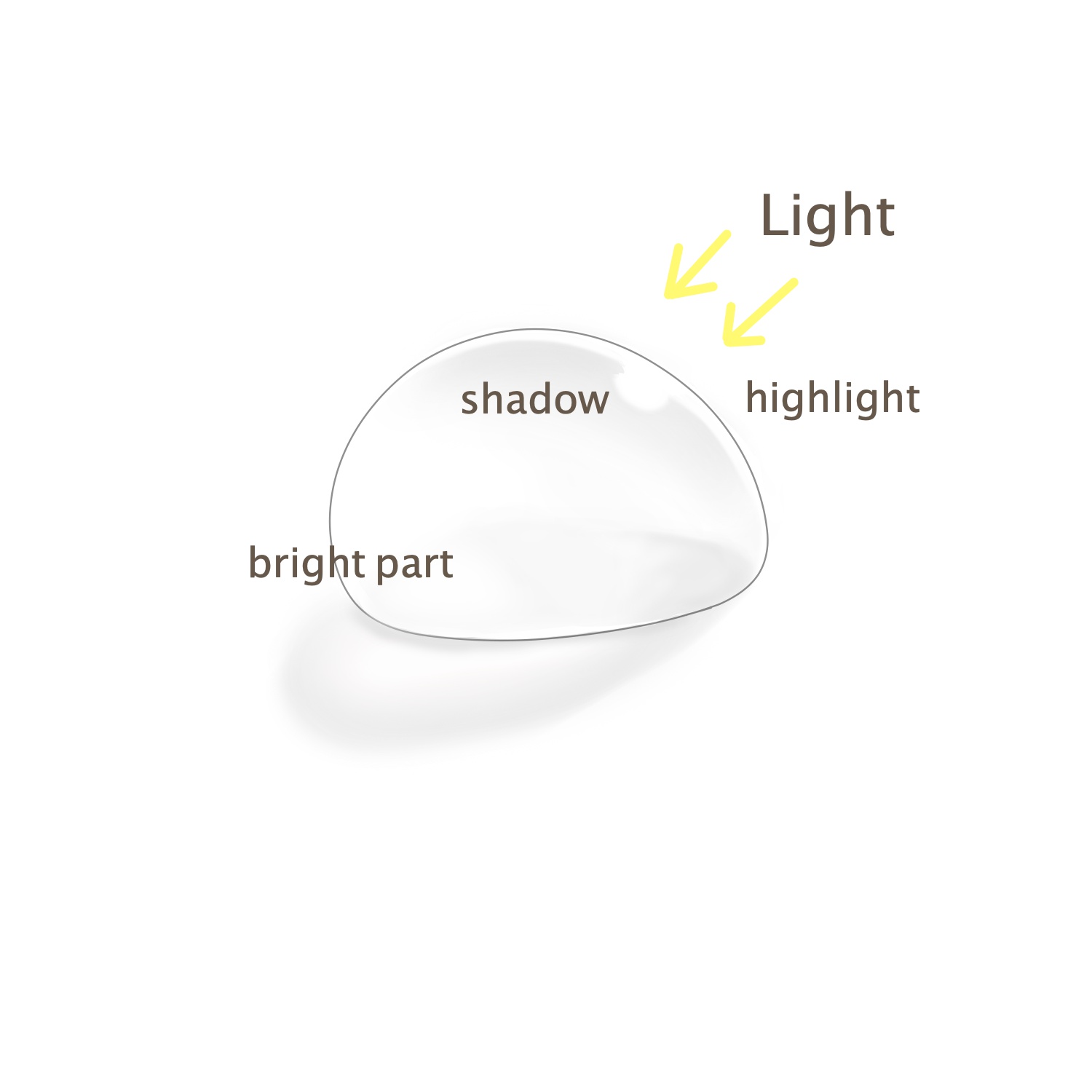
/highlight: light source side
/bright part: towards the opposite of the light source
/shadow: light source side
1-2.Reflection
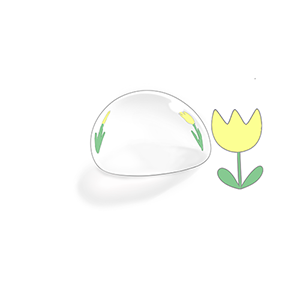
On transparent water drops, objects nearby are reflected, and objects on the other side can be seen through.
By thoroughly drawing the reflections, you can express the water drop trait more realistically, but you can skip this depending on the taste of your illustration.
For simple drawings, you can draw in a thick shadow on the inner side to express a water drop simply.
Depending on the taste, adjust how much you draw in.
1-3.Depending on the conditions, the inner side of the shadow may be bright
Light does not pass through ordinary objects, so on the opposite side of the light source, dark shadow forms.
On the other hand, light passes through water drops, so on the other side of the light source, a bright part may form on the shadow. 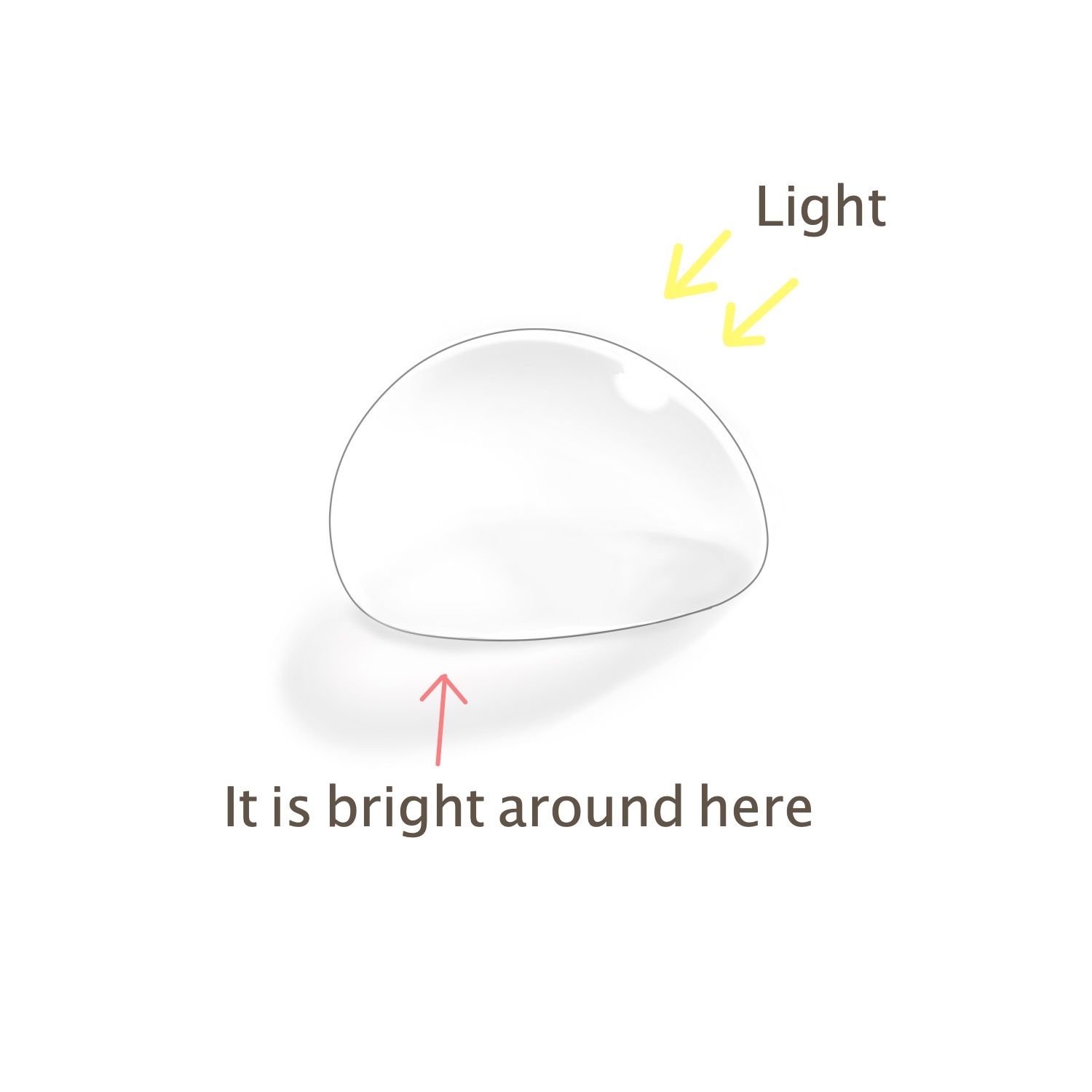
When the light source is nearly right above, far away, or the light is weak, the shadow forms as usual, so you don’t need to worry about it so much, but if you know about this, you can have more ways to express.
You can stress how transparent water drops are or stress the light, so it is also recommended for illustrations of shining morning dew.
2.How to draw water drops
Here, let’s look at how to draw water drops.
[Basic drawing techniques]
1.Draw the foundation with a somewhat thicker color than the base color
First, make a new layer and place it on top of the base layer.
After that, use a somewhat thicker color than the base color to draw the foundation on a new layer.
When you select the foundation color, it is easy to select when you imagine “a little thicker color than before” of drawing paper or cloths when they get wet.
2.Draw in the shadow
Next, draw the shadow on the light source side.
First, make a new layer, place it on the foundation layer, and do clipping.
Next, choose a somewhat darker color than the foundation and use an airbrush to put in shadow on the light source side.
When it’s hard to fit, use a Gaussian Blur to make it fit the base.
3.Draw in the bright part
When you finish drawing the shadow, this time, you put in light on the other side of the light source.
Select a somewhat brighter color than the base color and draw in using an airbrush.
When you do this, it fits better if you use the Gaussian Blur after you draw in.
For this process, you can save time if you draw it in the same layer as the shadow, then use Gaussian Blur at the point you finish drawing both the shadow and the light.
When you separate the layers, remember to do clipping on the layer of the light side as well.
4.Connecting the space between the shadow and the light
When you finished drawing the light part, next, draw the space between the shadow and the light like connecting the two.
First, make a new layer on the foundation.
Next, use the Pick Color to pick up the color of the border of the light and the foundation area, then use an airbrush to extend the colors to the area where you can see the foundation, making it be a gradation as you connect the colors to the shadow.
5.Insert light on the light source side
This time, draw in light on the edge on the light source side.
Make a new layer at the very top and do clipping. (It is fine to draw on the light layer as well.)
From the light on the opposite side of the light source, pick up the brightest color, and use an airbrush to trace along the wall of the water drop.
On the light source side, use the pen tool to insert white highlights.
Finally, draw in shadow that forms under the water drop.
Make a layer on the base layer and use an airbrush to draw in the shadow, then it’s complete.
For the shadow color, use Pick Color and pick up the darkest color of the shadow on the light source side.
Also, depending on the size of the bright part and shape of the highlight, the height and thickness of the waterdrop appear differently.
Make adjustments to match the water drop you want to draw.
Flowing sweat and tears basically follows the same drawing techniques.
To make the part that starts to flow connect to the base well, the point is to use an airbrush to make it fit. 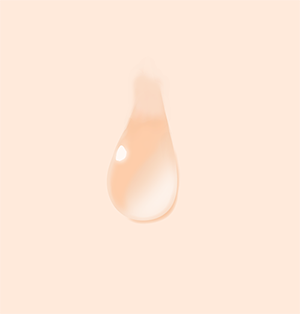
(Sweat/tears)
\ We are accepting requests for articles on how to use /





































































